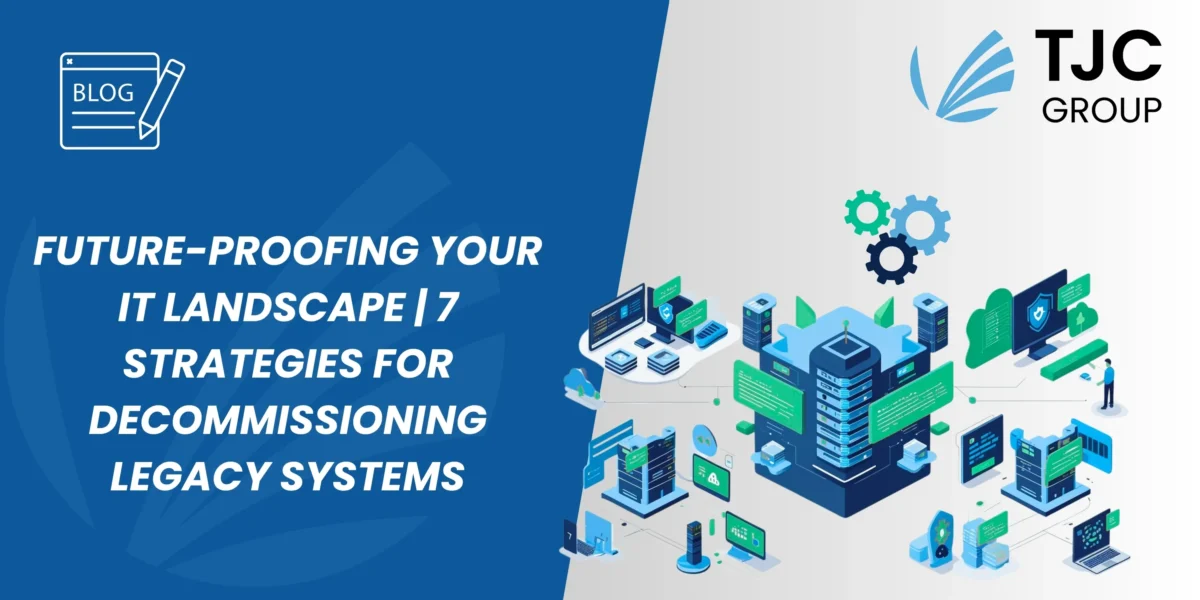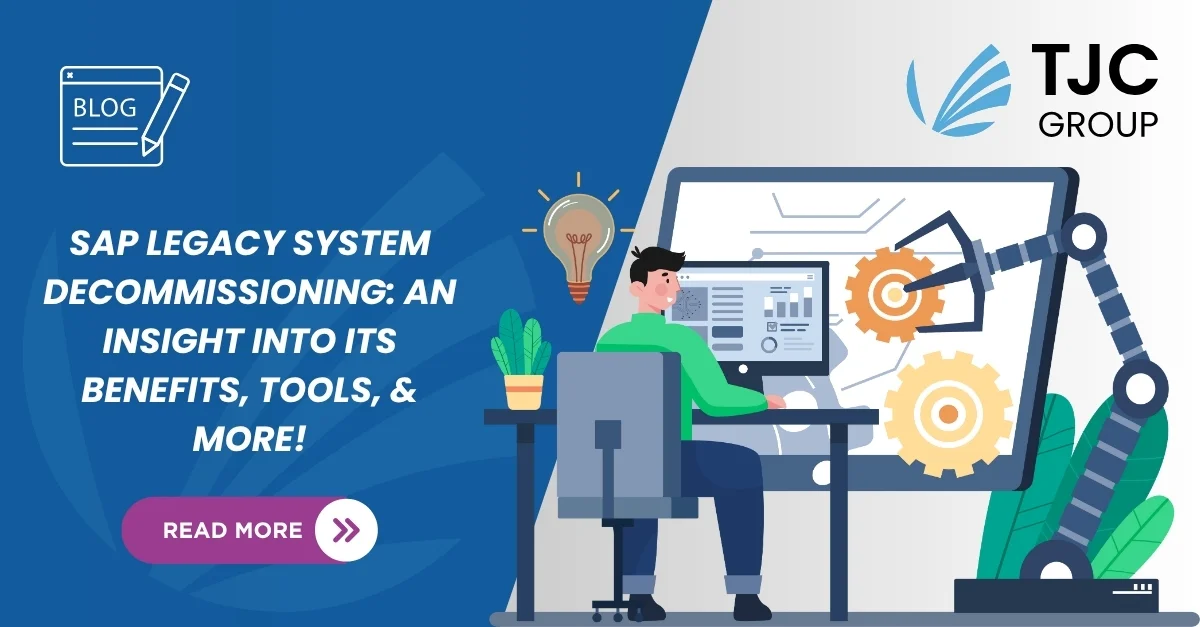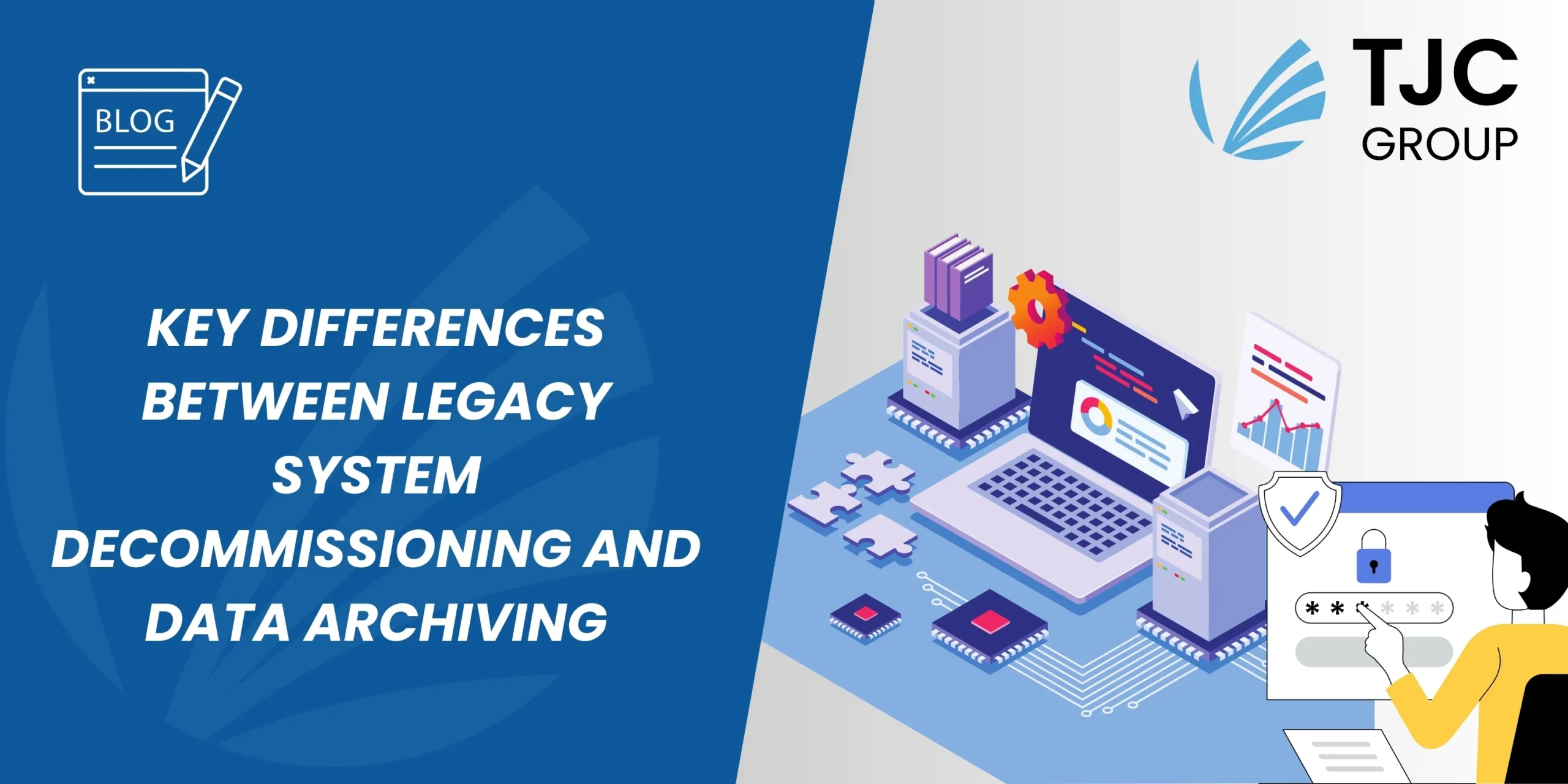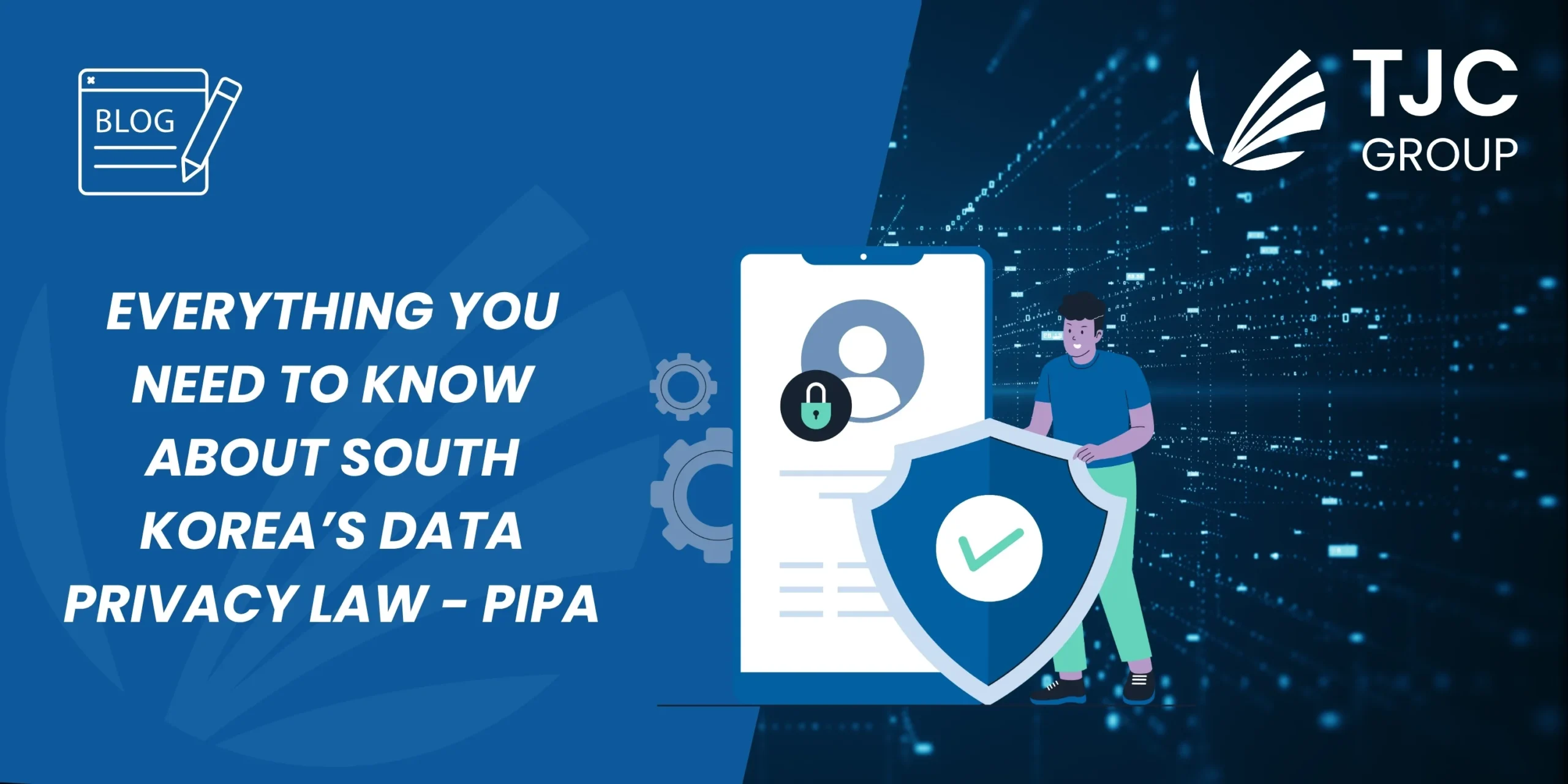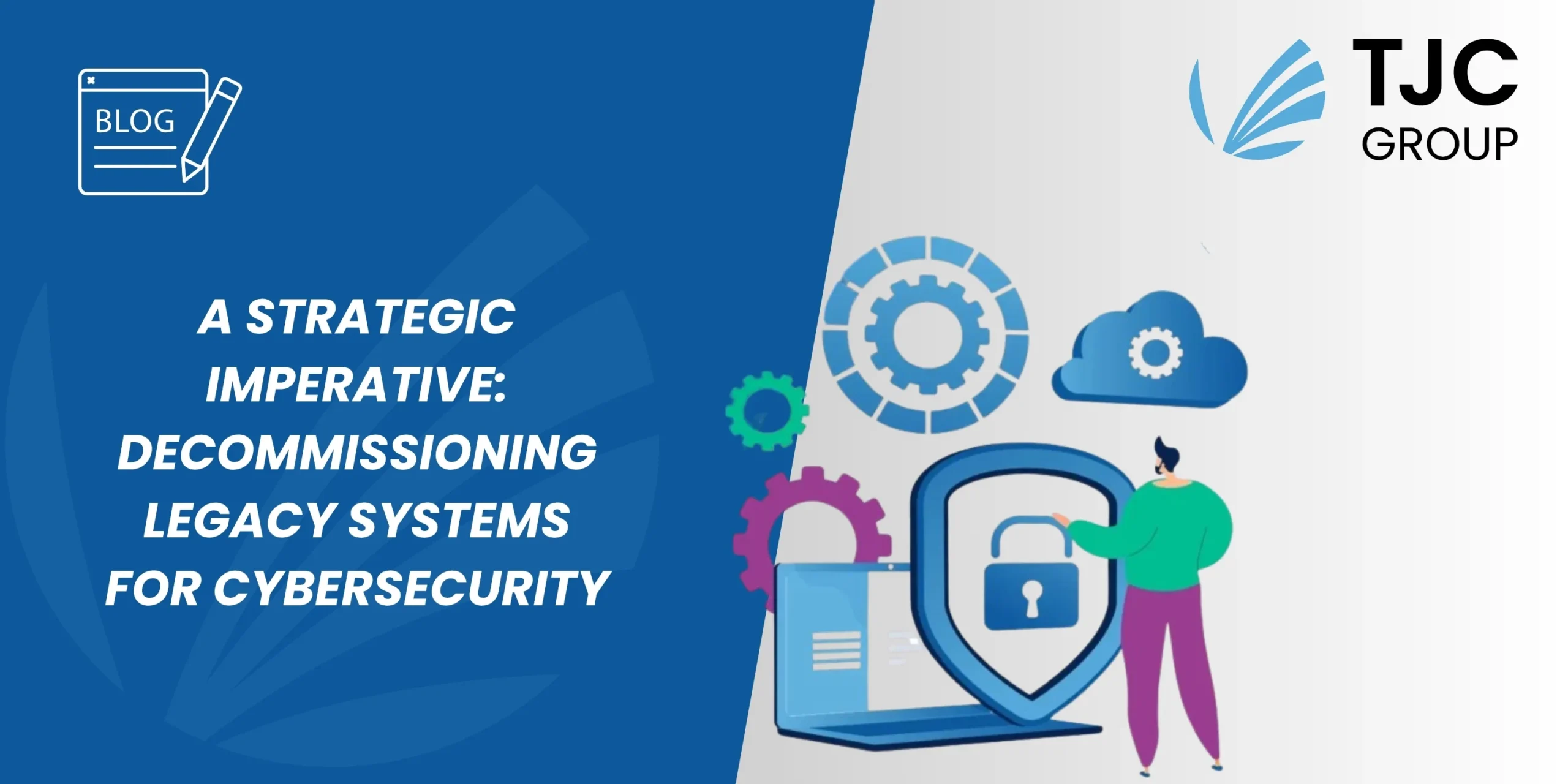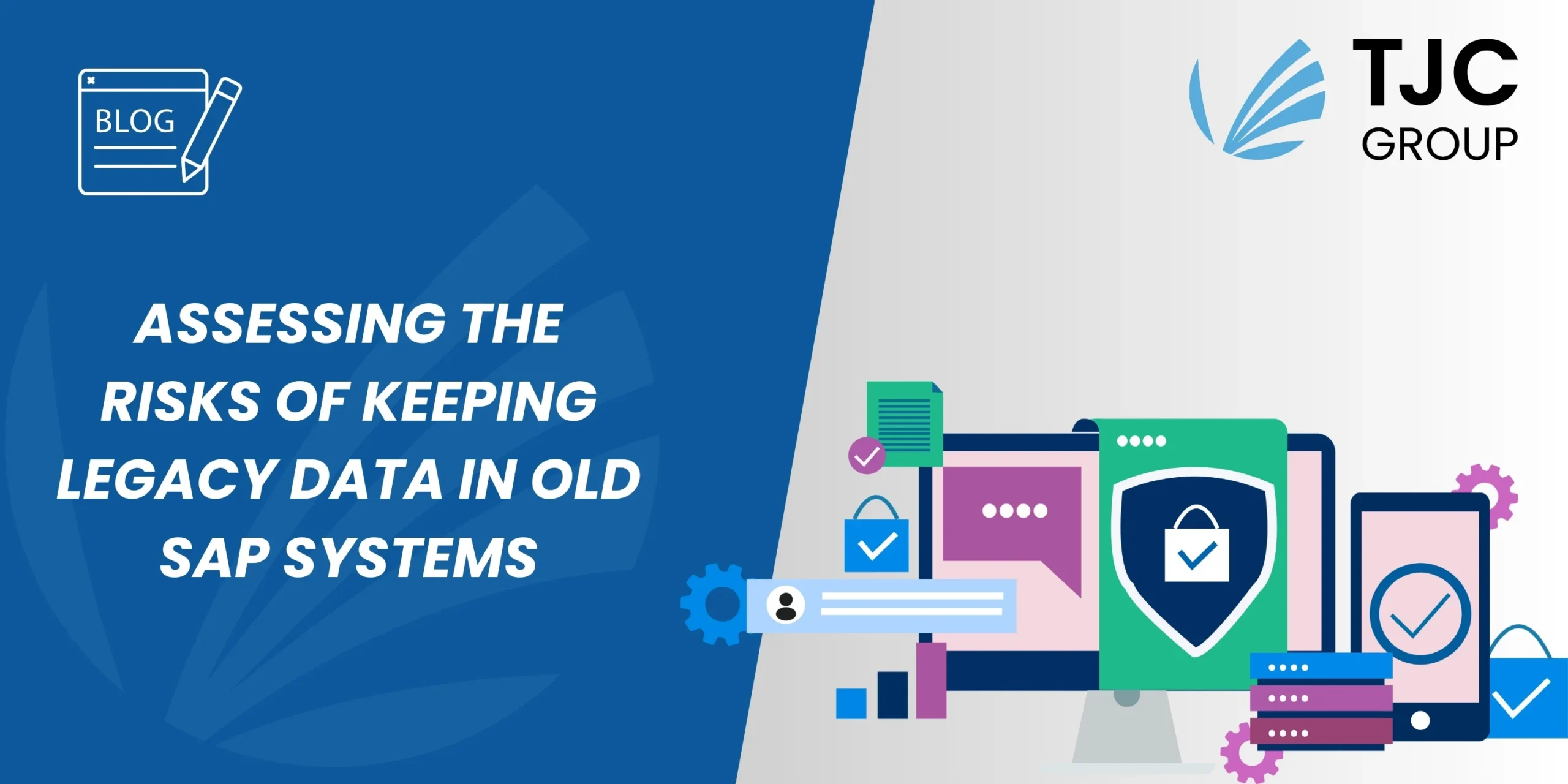Author: Priyasha Purkayastha, Global Content Manager, TJC Group | Co-author: Thierry Julien, CEO, TJC Group
Research states that 74% of organisations still depend on SAP legacy systems for their business operations. Organisations often withdraw from the idea of legacy system decommissioning thinking it is expensive. But truth be told, it is just a one-time expense that yields significant ROIs in the near future. However, decommissioning, if not done properly, can turn out to be time-consuming, leading to unwanted expenses. That’s why, following the best practices for SAP legacy decommissioning is quintessential. Let’s see what they are and how TJC Group comes to your assist.
Table of contents
Introduction
The IT landscape, over the last few years, has progressed leaps and bounds – now with AI and automation supporting innovations, the future looks even more technologically-advanced. For organisations it means that their business systems must be replaced or migrated to a new one as and when required. A classic example of this would be the recent shift to the SAP S/4HANA systems from the existing SAP ECC systems.
You see, in previous times, old systems that ran on mainframes were lost after removing the hardware. Then came keeping obsolete systems in data centres or migrating them into virtual machines (VMs). However, in today’s technology-backed, vulnerable digitalised landscape, these solutions don’t serve as adequate measures. Firstly, losing data in this AI age is not an option, and secondly, keeping old systems can turn to be financially challenging as well. Therefore, the strategic way forward is to decommission your legacy systems.
An overview of legacy system decommissioning
Legacy system decommissioning can be defined as a planned, carefully governed, and operationally irreversible process of safeguarding information while retiring obsolete systems or assets pertaining to information systems. It includes data stores, hardware, codes, cloud, middleware, as well as integrations, included from all execution environments and backups. Decommissioning these outdated systems help ensure that they are no longer operationally reachable while simultaneously discarding the associated licenses, hardware, maintenance and integrations costs. However, keep in mind that these disposals are done as per the corporate policies, vendor contracts, and environmental and privacy regulations. Additionally, the process also includes secure wipe procedures that helps eliminate the cost, security exposure, and the burden of technical debts.
Consequently, keep in mind that non-SAP or SAP system decommissioning is not a migration project. It is rather a process that helps ensure a much more streamline IT lifecycle management, enabling organisations stay updated with their technological needs.
Click on the banner below to learn more about SAP legacy system decommissioning:
Best practices for SAP & non-SAP legacy decommissioning
While decommissioning is truly a strategic move forward, there are several factors that organisations must weigh in before starting the process. So, regardless of whether you have a non-SAP system or an SAP one, you need to follow meticulous planning practices to ensure a smooth system decommissioning. Here are a few key best practices that you can follow –
Strategic planning of the project
The first and foremost thing to do before starting any project is to strategically plan it out. You have to develop a strong planning while ensuring transparency within your key departments. Decommissioning an obsolete system requires communication with several departments and having a robust and comprehensive blueprint comes in handy. Having said that, when planning your legacy system decommissioning project, ask these following questions:
- Do I decommission while migrating to a new system of after migration took place?
- What is legacy system scope for data, documents, reports, documentation, and tax extracts? Define retention requirements when possible.
- Who will access the data (users, auditor’s)
- Do I need to apply personal data deletion on legacy data over time?
- How to ensure data security and regulatory compliance going forward?
Have a thorough discussion with your team about the project and evaluate every detail carefully, as decommissioning will have significant implications not only at the organisational level but also in terms of financial impact.
Choosing the architecture per your IT environment
Possibly one of the best practices for SAP legacy decommissioning (or non-SAP), you need to choose an architecture as per your IT landscape.
Make no mistake, we are not discussing the migration process of migrating, let say, ECC to S/4HANA. We’re discussing the new architecture for storing and accessing information from the ECC system.
You see, a decommissioning project consists of several aspects like rearchitecting, rebuilding, and replacing your old IT infrastructure, leading to better and more advanced capabilities. It is essential to analyse the architecture carefully before implementing it into your IT infrastructure. Choose an architecture that fits well within your target or existing environment. This helps avoid additional efforts during the project as well as after for maintenance. Moreover, map it based on the technology, functionality, cost and risk factors, weighing in all the options to identify the process that requires minimum efforts but delivers maximum results.
Careful data extraction from the legacy system
Data extraction is crucial for both non-SAP and SAP system decommissioning. To explain data extraction – it is a process of collecting and retrieving a range of diverse data from obsolete systems that are scheduled for decommissioning. It is pivotal because it helps in consolidating, processing, and auditing data that must be stored in a centralised location. Also keep in mind that the centralised location where the extracted data will be stored can vary from on-site, cloud-based, or even a hybrid of the two.
Not to forget, once the data is extracted, essentially check the accuracy of the data. Prepare an audit report that will help ensure the completeness as well as the integrity of the extracted data. This will, furthermore, ensure the correctness of data between the extracted files and the source. That said, the audit report will also help demonstrate that the planned data set for extraction was indeed extracted while remaining unchanged, thereby qualifying as tax archives.
Uploading the extracted data
Uploading the extracted data into a storage system (kindly bear in mind that we are not discussing a record management system here, as we need to store data, document and reports all together), whether the cloud, hybrid, or on-premises, is an important strategy for legacy system decommissioning. This includes data or applications storage from an on-premises system to the cloud, transferring data within and between cloud environments, and so on. Notably, most organisations are expected to operate on the cloud entirely within the next few years – thanks to the rapid growth of cloud migration and storage.
Anticipating user requirements
One of the best practices for SAP legacy decommissioning or a non-SAP one is anticipating the requirements of the users. Businesses may have new requirements once the obsolete systems are retired. A smart strategy here is to define the scope of extracting relevant data, attachments, documents, or even reports, while deploying the project. This will not only help streamline the decommissioning but also limit any unprecedented custom requirements. Additionally, it can save any additional costs that may come with unexpected requirements.
However, you need to keep in mind that in practicality, anticipating user requirements, more often than not, becomes tedious. Keeping all data and being ready to define user access at a later date, is usually the cheapest and most effective way in such situations.
Watch our webinar on how GenAI helps drive S/4HANA transformation with decommissioning.
Preparing to mitigate and manage obstacles
Ensuring data integrity, regulatory compliance, and business continuity forms a significant part of risk management and mitigation. Whether you opt for SAP system decommissioning or a non-SAP decommissioning, preparing to mitigate potential risks is quintessential. One of the major risks that organisations often worry about is losing critical data during the decommissioning process. However, with comprehensive data extracts, including but not limited to backups, you can take a breath of relief. Additionally, implementing data validation tools and incremental archiving to reduce errors during migration of data also comes in handy. Lost or corrupted data may no longer be extracted once decommissioning is complete. At this stage, lost or corrupted data in the legacy system, once identified, can only be documented for reference. This is why TJC Group solutions include automatic audit reports that may be used at decommissioning time, or after decommissioning project.
Ensuring compliance and legal requirements
Failing to comply with legal and regulatory requirements during and after the legacy system decommissioning process can lead to penalties. The best move forward is to develop data retention policies that are aligned with regulations like the GDPR, SOX, HIPAA, and so on. Additionally, implement SAP Information Lifecycle Management (SAP ILM) that will enable automation of compliance management, maintaining audit trails, generating automated reports, and collaborating with legal and compliance teams.
Decommissioning is still a quite recent process from the 21st century, and data privacy regulations were only marginal up to 2018, so IT department may not be fully familiar with it. In fact, at times, decommissioning may be confused with installing a record management system or some sort of tax archive limited setup.
ELSA by TJC Group: Your go-to solution for legacy system decommissioning
Even with the best practices for SAP legacy decommissioning or non-SAP system retiring, the process can still be tedious. The Enterprise Legacy System Application or ELSA by TJC Group is here to simplify the process while organisations can leverage its state-of-the-art benefits. ELSA’s architecture helps strike a balance between the advanced capabilities and practical, real-world applications. Organisations, depending on their infrastructure needs, can deploy ELSA with data as well as databased that are hosted either in the cloud or on-premises. Additionally, TJC Group’s decommissioning solution, ELSA, includes easy to implement data destruction (including mass destruction) as and when needed.
Our Enterprise Legacy System Application supports both SAP and non-SAP legacy system decommissioning, thereby eliminating the need and complexities of data management across multiple sources.
Here’s how ELSA helps implement the key strategies for decommissioning –
Automates the process
As the world moves toward smarter and more automated solutions, adopting tools powered by process automation, artificial intelligence (AI), and machine learning (ML) is becoming strategically important for organisations.
TJC Group’s ELSA is designed with built-in automation features that significantly streamline decommissioning projects. For example, key business and customising tables are automatically identified and suggested for import into the database. At system startup, hundreds of generic transactions are preconfigured based on the SAP tables in your environment, including the custom ones. Additionally, hashkey and data lineage tracking are performed, stored, and accessed automatically in a transparent manner. Moreover, ELSA comes with the ability to use AI-driven tools that intelligently classify and categorise data, thereby reducing manual effort and improving accuracy.
Flexible to customer requirements
Like mentioned above, choosing the right architecture helps simplify the non-SAP and SAP system decommissioning process. However, it is also important to be flexible with the solutions, regardless of the architecture. In fact, within TJC Group, we refer ‘ELSA to ELSE’ process i.e., the flexibility of moving from ELSA to something else, as and when needed by the organisation. This is also referred to as an exit path; however, when selecting such an option, it is important to bear in mind that data from the obsolete systems are not “dead data”.
Just two examples: data deletion that was applied need to be understood in future application and data that have been accessed by users and extracted by auditors also needs to be available when decommissioned. As a matter of fact, these legacy data can be accessed and lineage/traceability can be enforced, while being redacted or deleted from time to time for data privacy. Our ELSA process provides organisations with original extract while also enabling evolution with data kept as legacy.
Compliance with data privacy regulations
TJC Group’s cloud-based legacy system decommissioning solution, ELSA, is designed with data privacy compliance at its core. When retiring legacy systems, the platform must be a native tax archive or produce two distinct datasets. These datasets can be –
- one for tax purposes
- another for business use
TJC Group simplifies this by providing a single extract that meets all requirements. ELSA can act as either an intermediate or definitive archive, seamlessly connected to the live ERP system.
Live systems must adhere to regulations such as GDPR, Law 25, SOX, HIPAA, and others. While SAP addresses this through SAP Information Lifecycle Management (ILM) with Retention Management, which supports mass data deletion based on defined policies, this alone is insufficient. However, once a system is decommissioned, its processes are no longer updated, rendering those retention rules ineffective (e.g., a delivery will never record a payment in a legacy system). Most solutions on the market simply rely on existing retention rules, and this does not work because business processes are left unfinished. ELSA complements SAP ILM by enabling both standard and surgical data destruction. Our focus is on precision, ensuring that only personal data is removed while preserving critical information: easier to perform, more business data available for building AI agents.
Complete data extraction
One of the best practices for SAP legacy decommissioning or non-SAP systems is data/document/reports extraction. With TJC Group’s ELSA, we ensure 100% extraction of accessible non-empty data tables, documents, and other attachments from the system scheduled to be decommissioned. Here, businesses must decide on what they want to see once the system is retired – a standard reporting output or a custom reporting output. A full or 100% extraction, classically, means that data and documents are available as and when needed like for audits, compliance, and similar situations.
Working with TJC Group for legacy system decommissioning
Retiring outdated systems is a strategic move that aligns your organisation with modern data management practices. But let’s face it – legacy system decommissioning is sometime complex, resource-intensive, and often caught-up in the web of compliance challenges. That’s where an expert guidance can make all the difference; guidance is important in any non-reversible process, because there is no way back.
At TJC Group, we take this complexity and turn it into clarity. With our proven methodologies and cutting-edge tools, saying goodbye to obsolete systems becomes not just manageable, but transformative. We bring the following to the table –
Comprehensive SAP expertise
Apart from implementing the best practices for SAP legacy decommissioning (or non-SAP ones), we come with deep knowledge in SAP and beyond, specialising in:
- SAP data archiving
- SAP ILM retention and warehouse management
- Tax and technology solutions tailored to your business needs
Consequently, we help bridge the gap between technical teams and stakeholders, ensuring alignment across the organisation.
Cutting-edge technology
With over 40% of our workforce dedicated to R&D, we continuously enhance our tools to deliver secure, efficient, and scalable solutions. At TJC Group, we believe and empower innovation, aligned with today’s automated and ai-savvy world.
Seamless integration with ELSA
Our cloud-based application, the Enterprise Legacy System Application (ELSA), is built on SAP BTP and designed to automate the decommissioning process. Our team ensures to simplify the process and offers unmatched integration capabilities, customised to the unique requirements of our clients.
Subject matter experts
Our specialised teams in legacy system decommissioning, data archiving, and ILM bring deep domain knowledge to every project. We help you stay ahead of evolving regulations, minimise compliance risks, and ensure smooth project delivery from start to finish.
Partner with us for a streamlined non-SAP and SAP system decommissioning journey that delivers measurable gains and long-term impact.
Commonly asked questions
Q1. What is legacy system decommissioning, and why should organisations consider it?
Answer:
Legacy system decommissioning is a planned, carefully governed, and operationally irreversible process of safeguarding information whilst retiring obsolete systems. Unlike simply switching off old systems, proper decommissioning ensures critical data remains accessible whilst eliminating ongoing costs associated with maintaining outdated infrastructure. With 74% of organisations still depending on SAP legacy systems, many hesitate to decommission due to perceived costs. However, decommissioning is a one-time investment that yields significant ROI by eliminating licensing, hardware, maintenance, and integration expenses, whilst also reducing security vulnerabilities.
Q2. What are the key risks of not properly planning a legacy system decommissioning project?
Answer:
Without strategic planning, decommissioning can become unnecessarily time-consuming and expensive. Critical data may be lost or corrupted during extraction, making it impossible to recover once the legacy system is shut down. Organisations also risk non-compliance with legal and regulatory requirements, such as GDPR, SOX, and HIPAA, potentially leading to significant penalties. Additionally, inadequate planning may result in business disruption if users suddenly lose access to historical data they require for ongoing operations or audits.
Q3. How should organisations approach data extraction during the decommissioning process?
Answer:
Data extraction is crucial for both SAP and non-SAP system decommissioning. The process involves collecting and retrieving diverse data from obsolete systems scheduled for retirement. This data must be consolidated, processed, and audited in a centralised location, which could be on-site, cloud-based, or a hybrid solution. After extraction, it’s essential to verify data accuracy through audit reports that ensure completeness and integrity. These reports demonstrate that the planned data set was extracted unchanged, qualifying as tax archives and maintaining compliance with regulatory requirements.
Q4. How does decommissioning support compliance obligations?
Answer:
Failing to comply with legal and regulatory requirements during and after decommissioning can lead to penalties. Best practice involves developing data retention policies aligned with regulations like GDPR, SOX, and HIPAA. Solutions like TJC Group’s ELSA are designed with data privacy compliance at their core. When retiring legacy systems, your platform must either be a native tax archive or produce two distinct datasets—one for tax purposes and another for business use. Additionally, proper decommissioning solutions should enable both standard and surgical data destruction, ensuring that only personal data is removed whilst preserving critical business information.
Q5. What advantages does using a specialised solution like ELSA offer?
Answer:
ELSA by TJC Group automates much of the decommissioning process, with built-in features that streamline projects. For example, key business and customising tables are automatically identified and suggested for import into the database, and hundreds of generic transactions are preconfigured at system startup based on the SAP tables in your environment, including custom ones. ELSA ensures 100% extraction of accessible non-empty data tables, documents, and attachments from systems scheduled for decommissioning. It also offers flexibility to customer requirements through the ‘ELSA to ELSE’ process, allowing organisations to move data to other systems when needed. Most importantly, ELSA complements SAP ILM by enabling precise data management that addresses the unique challenges of decommissioned systems where business processes are no longer updated.


